Do you love raw, unpasteurized apple cider vinegar? Have you ever thought about fermenting it yourself? It's such a fabulous idea, because making your own apple cider vinegar is really uncomplicated, an exciting biochemical project, and besides, you have the possibility to control the quality and taste yourself.
Jump to recipeFor this recipe, you would ideally use the pomace from making apple juice. Almost as good are the apple peels and cores that are left over from processing apples and often end up in the trash. By using these parts of the apple, you not only reduce your waste, but you also increase the nutritional value of the vinegar. The peels and cores contain many valuable nutrients, such as pectin, which is good for digestion, as well as antioxidants and vitamins.
So, the next time you eat apples, save the peels and cores and use them to make apple cider vinegar. Fallen fruit is also good to use. You'll also need sugar and water, yeast is optional.
Making apple cider vinegar is a two-step process
First, the fruit's own and added sugars must be converted into alcohol by the wild yeasts that are present on the apples and in the air. For the alcoholic fermentation, as is usually the case, it is not necessary to exclude oxygen, so you can simply use any container, which you protect with a cloth and rubber band against dust and fruit flies. This is because the process of alcoholic fermentation of fruits and fruit juices is due to the conversion of simple sugars into ethanol by crabtree-positive* yeasts, especially saccharomyces cerevisiae.
These yeasts produce alcohol even during aerobic fermentation and are found in nature especially on fruits. As discussed among hobby brewers, it is practically impossible to saturate the batch with so much oxygen at home that no alcoholic fermentation would take place. Handy, isn't it?
In the second step, when alcohol has been produced, the acetic acid bacteria play the main role. They are also naturally present in the air and on the fruit itself and need oxygen to ferment the alcohol into acetic acid. Therefore, you can simply continue to use the same vessel.
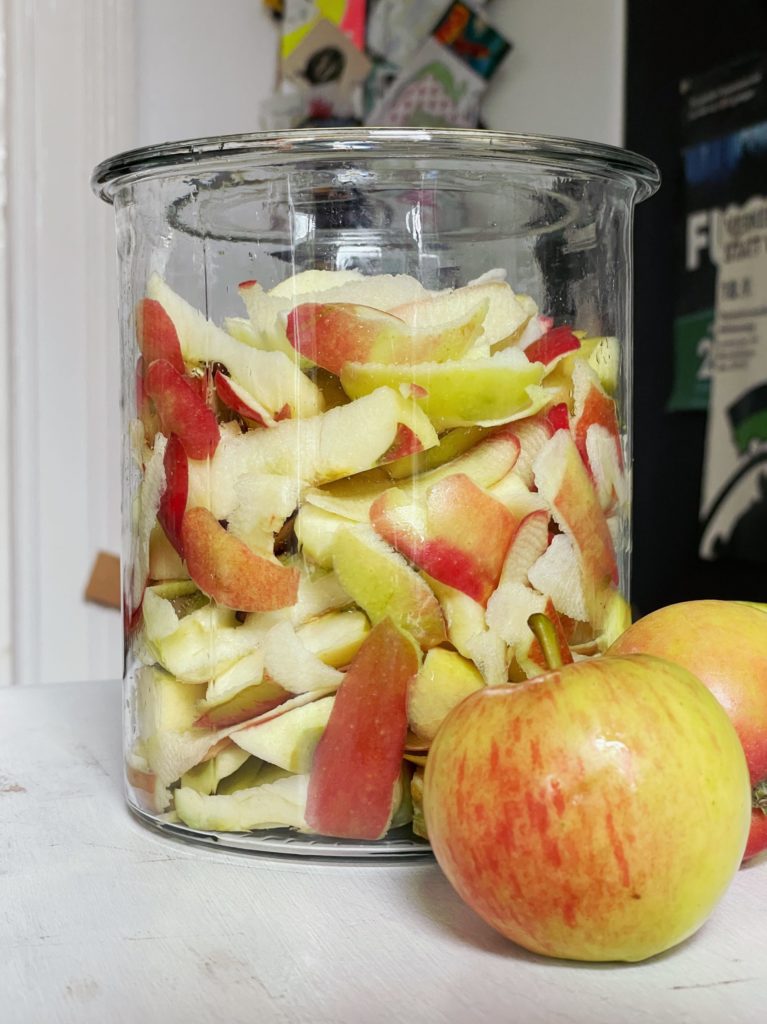


Apple cider vinegar or apple pieces in sugar water?
On the Internet and on social media, you often see a few roughly chopped apple pieces floating in sugar water, which is then supposed to become apple cider vinegar. This concoction of apple-flavored sugar contains none of the valuable ingredients that would be found in real apple juice, and taste-wise, the result doesn't even come close to good, traditionally prepared apple cider vinegar.
It's a bummer when you miss out on so much. Especially because good apple cider vinegar is not too complex to make. With the pomace left over from pressing, sort of an infusion of apples in water and some added sugar, you have a wonderful way to utilize the leftovers and make a great all-purpose vinegar with lots of flavor and nutrients. Also small chopped apple scraps in large quantities are a great base for making your own apple cider vinegar.
Do you need extra sugar to make your own apple cider vinegar?
In this recipe, sugar is added. The sugar serves as food for the wild yeasts and is largely, if not entirely, broken down during the fermentation process. The fructose from the apples may be sufficient, but will not reliably give you the same, best result, so I recommend the small addition of raw cane sugar or table sugar.
I am frequently asked if honey or maple syrup can also be used. The answer is yes, both can be used as a sugar source for fermenting apple cider vinegar, as both contain a high amount of sugar. However, it is important to note that using them will affect the taste of the apple cider vinegar because the sweetness may overpower the tart taste. Besides, it does not work quite as well and makes the whole process take longer.
Is that kahm yeast on the apple cider vinegar?
A few days after you stop stirring your apple cider vinegar, you may see what looks like kahm yeast is developing. Of course, it's possible that it really is developing kahm yeast - in which case you should remove it with a kitchen towel and add a shot of finished vinegar to prevent re-growth.
However, it is also possible that the supposed kahm yeast layer is a developing vinegar mother, a mixture of microorganisms responsible for the fermentation of alcohol into vinegar.


A vinegar mother develops naturally
It consists of acetic acid bacteria and yeasts, which bond in the form of cellulose threads and form on the surface of the apple cider vinegar. This mother is a natural component of apple cider vinegar. It ensures that the apple cider vinegar continues to ferment and the acetic acid bacteria are increased, resulting in the formation of more acetic acid. In addition, the mother also contains enzymes and probiotic bacteria that can provide health benefits.
It is desirable for homemade apple cider vinegar to grow a vinegar mother. Adding unpasteurized vinegar after 5-6 days can promote growth.
Make your own balsamic vinegar from apple cider vinegar
Homemade apple cider vinegar is already great, but have you ever made your own apple balsamic vinegar? Give it a try and be surprised! Fermenting apple cider vinegar and apple balsamic at home is a great way to add homemade and healthy ingredients to your kitchen. It doesn't require much effort or materials, and you'll be rewarded with delicious and nutritious products.
You need a really good apple cider vinegar for this, preferably the one you fermented yourself. And preferably homemade, long boiled apple syrup.
It can be done even easier, with added sugar.
Good quality - and save a lot of money
For really good apple balsamic vinegar prepare a mixture of 80% apple cider vinegar and 20% apple syrup. Then, depending on the desired sweetness and taste, simply add more vinegar or syrup and let it mature in a closed bottle in the dark. For extra flavor, you can also store your balsamic in a wooden barrel or add a few wood chips for flavor: Chestnut gives a tannic aroma, cherry highlights the fruity sweet note, juniper spices and oak round out the flavor.
If you do not use syrup, put the apple cider vinegar in a saucepan and add sugar, 1-2 tablespoons per 250 ml of vinegar. Reduce to half its volume on low heat. This will take a couple of hours. Once the apple balsamic has thickened, pour it into a clean bottle and let it settle. Again, you can add aromas of woods.
You now have your own homemade apple balsamic!
* The crabtree effect (after the English biochemist Herbert Grace Crabtree; also glucose effect) describes that under certain conditions yeast cells produce ethanol instead of carbon dioxide even in the presence of oxygen. This occurs when the glucose concentration exceeds a certain value.
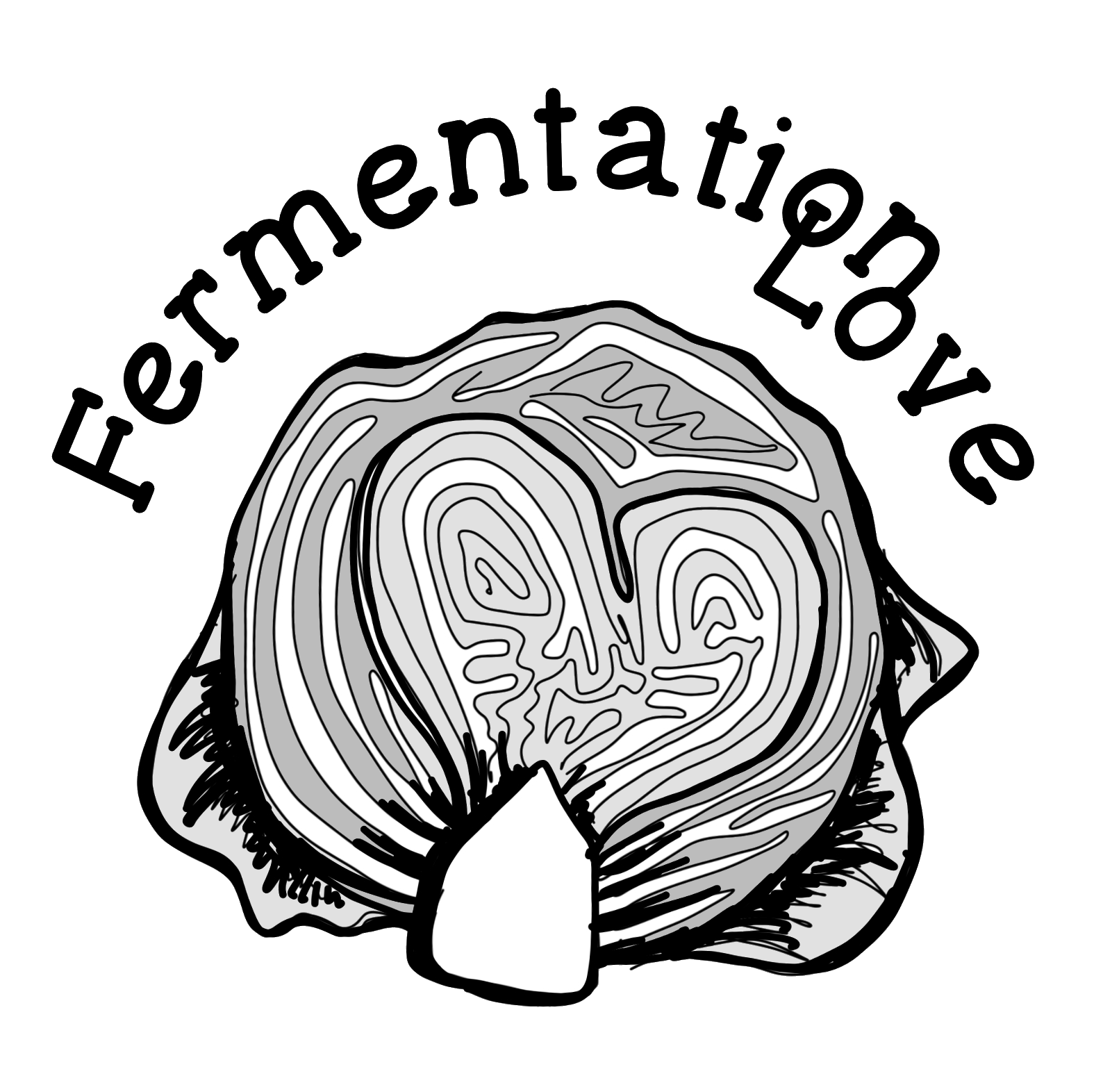
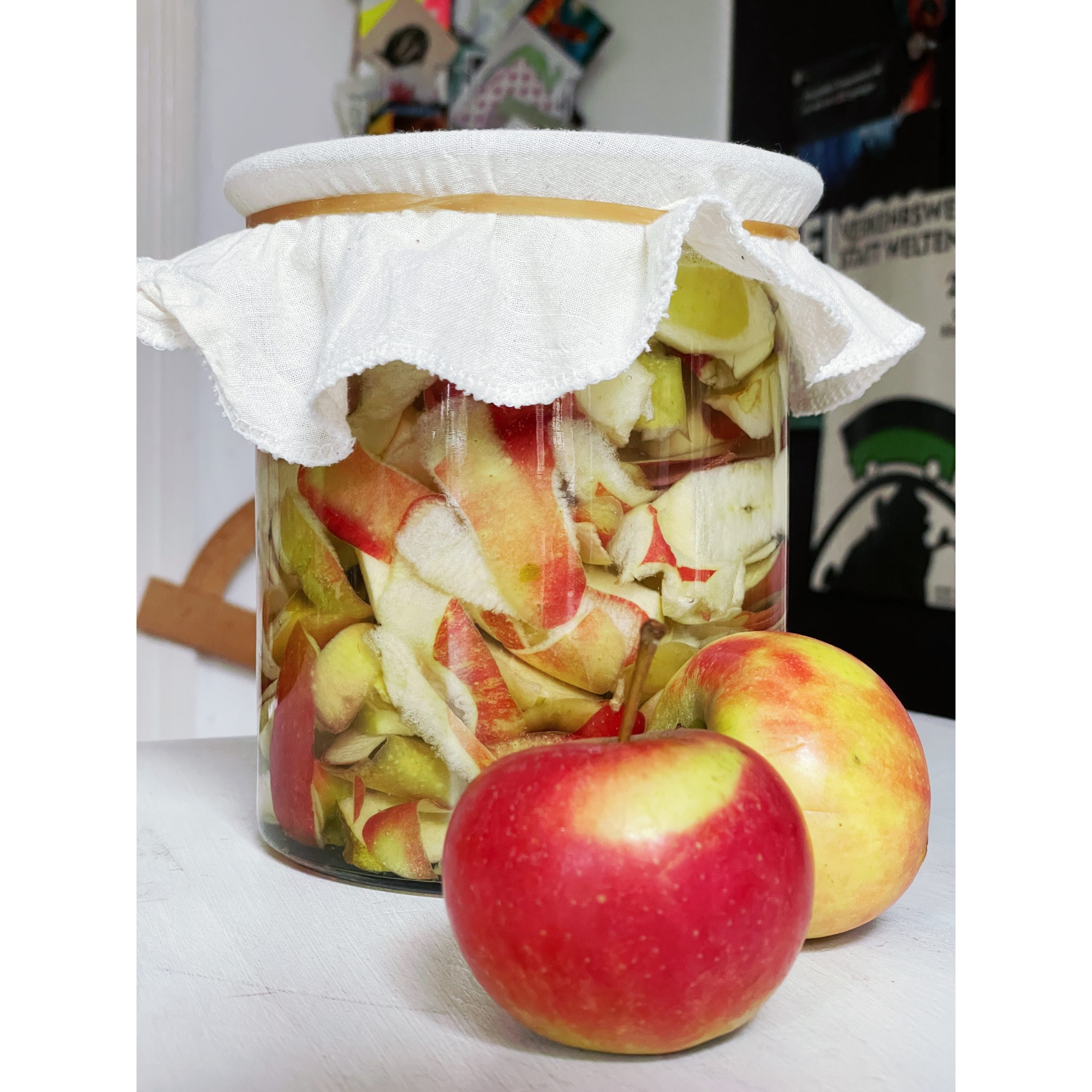
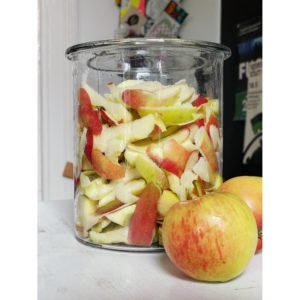
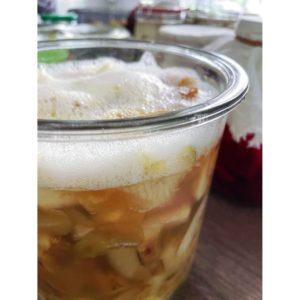

What kind of syrup do you use to make the balsamic?
Hi Kelly,
I use apple syrup, as mentioned in the paragraph above the one you’re referring to. I clarified, so now it’s easier to follow.
Enjoy!
Katsu
Es gibt mittlerweile ja die Apfelsaftkonzentrate im Handel zu kaufen die man 1:4 ansetzt um dann Apfelsaft zu erhalten.
Um dann Balsamico zu machen würden sich diese Saftkonzentrate sicher gut eignen.
Gibt es auch in Bio und sind ungefähr gleich was den Preis von Apfelsaft angeht.
Also 250ml Konzentrat kosten soviel wie dann der fertige 1l Apfelsaft
Hallo Katsu,
wann gibt man denn die Essigmutter in den Ansatz? Gleich zu Beginn zu den
Apfelstücken oder erst nach 3-4 Wochen, nachdem abgesiebt wurde? LG, Ursula.
Hej Ursula,
die Mutter entsteht auf natürliche Weise. Wenn du schon eine besitzt und sie hinzugeben möchtest, empfehle ich, das nach dem Filtern zu tun, damit sie nicht mit den Apfelstücken verwächst. Ausserdem sollte die alkoholische Gärphase abgewartet werden.
Gutes Gelingen!
Katsu
Grüß dich, Katsu!
Ich habe das letzte Mal vor zwei Jahren Apfelessig gemacht und heute eine Flasche geöffnet.
Der Essig riecht alkoholisch und beim Schütten reagiert er ähnlich wie Sekt.
Definitiv ist kein Schimmel, keine Kahmhefe zu sehen, unten hat sich Essigmutter gebildet.
Kann ich den Essig noch als Lebensmittel nutzen?
Es sind etliche Flaschen aus derselben Herstellung, wäre echt schade drum…
Liebe Grüße.
Ela
Hej Ela,
die Frage kann ich dir nicht beantworten, das musst du selber entscheiden. Parameter zur Entscheidungshilfe sind: Wie wurde fermentiert, wie wurde gelagert, wie ist der pH-Wert, Geruch und Geschmack?
Alkohol ist die Vorstufe zum Essig, wie du im Beitrag lesen kannst.
Bleib gesund!
Katsu
Hallo
Wie lange lasse ich denn den Apfelbalsamico nach dem Reduzieren ablagern?
Und soll der normale fertige Apfelessig in geschlossenen Flaschen gelagert werden?
Besten Dank
Hej Andreas,
du kannst ihn nach ein paar Wochen geniessen, aber auch länger lagern. Ich empfehle, ihn immer mal wieder zu probieren, um den optimalen Zeitpunkt für dich herauszufinden.
Viel Erfolg!
Katsu
Hallo Katsu,
danke für die ausführliche Einleitung. Ich habe es ähnlich gemacht und habe ein paar Fragen:
1- die Apfelstücke habe ich kurz in den Blender gegeben, daher sind nicht so schwer, unter dem Wasser zu schwimmen. Also die sind nicht komplett unter Wasser. Ist das schlimm? Ich hab zwei Finger Platz gelassen zur Oberfläche.
2- In unserem Haus ist nicht so warm, knapp 18-19 Grad. Wie viel länger könnte die erste Phase dauern? Wie merke ich das?
Danke im voraus!
Alma
Hej Alma,
wenn das Apfelmus auftreibt, rühre es bitte täglich mehrfach um. Und 18-19° C ist zu kühl, kannst du den Essig neben den Herd stellen? Wäre schade, wenn er nicht gelingt.
Viel Erfolg!
Katsu
Moin Katsu, ich hab das neben den Herd gestellt und alles nach Anweisung gemacht. Mittlerweile steht das Glas im Dunkel und kommt ein schönes Duft raus. Wie lange soll das Glas stehen? Ich sehe keine dicke Schicht oder Essigmutter. Vielen Dank vorab! Alma
Hej Alma,
wenn dir der Essig schmeckt, kannst du ihn abfüllen. In den Flaschen reift er dann noch nach. Es entsteht nicht jedes Mal eine Essigmutter, deswegen ist das kein deutliches Zeichen.
Gutes Gelingen!
Katsu
Sag, Du Liebe, welche Früchte kann ich statt Äpfeln und Birnen noch nehmen?
Muss dabei dann etwas anderes bedacht werden?
LG Dori
Hej Dori,
du kannst aus jedem 8-9%-igen Alkohol Essig machen. Wenn du die Früchte also zu Wein fermentieren kannst, sind sie zur weiteren Transformation geeignet.
Gutes Gelingen!
Katsu
Danke ☺️
Hej Katsu!
Wahnsinnig interessant wie man Essig selbst herstellen kann. Ich bin noch unsicher, wir werden im Herbst einen Jahresvorrat Apfelsaft pressen. Da fällt natürlich viel Trester an. Würdest du geschmacklich Eher den Apfelmost Oder mit Trester die Variante empfehlen?
Habe auch einmal von einem Verfahren gehört wo der Trester in Wasser eingelegt wird und dann noch einmal gepresst wird. Kennst du das?
LG
Chris
Hej Chris,
Most wird das bessere Ergebnis liefern, aber probiere doch mal beide Varianten aus. Einen direkten Vergleich finde ich total spannend. Das wiederholte Pressen des Tresters kenne ich nicht.
Gutes Gelingen!
Katsu